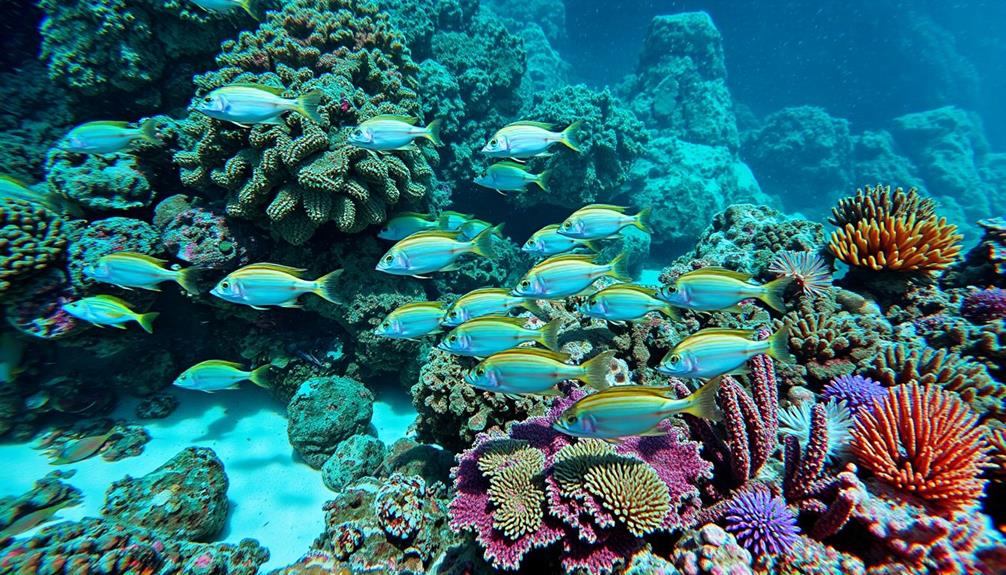Deciding between freshwater and saltwater sucker fish depends on your tank goals and budget. Freshwater species, like common plecos, are easier to care for and cost less to maintain. They adapt well to varied conditions and are ideal for beginners. Saltwater suckers, such as blennies, boast vibrant colors and unique behaviors but require more complex setups and frequent maintenance. Consider your experience level, aesthetic preferences, and budget before making a choice. Both options offer distinct benefits, and exploring further can help you make an informed decision tailored to your aquarium vision.
Key Takeaways
- Freshwater sucker fish are more beginner-friendly, requiring simpler setups and lower maintenance costs compared to saltwater species.
- Saltwater sucker fish offer vibrant colors and unique behaviors, enhancing the visual appeal of your aquarium.
- Consider your budget; freshwater setups are generally cheaper and easier to maintain than saltwater tanks.
- Freshwater environments are adaptable, while saltwater species need stable water conditions and complex ecosystems.
- Assess compatibility and social dynamics, as freshwater sucker fish thrive in community tanks, while saltwater species can coexist with reef fish.
Freshwater Sucker Fish Overview
Freshwater sucker fish, like the common pleco, play an important role in maintaining a clean aquarium by feasting on excess algae. These freshwater fish are popular among aquarists for their algae-eating capabilities and hardy nature, making them ideal for beginners.
One well-known species is the Bristlenose pleco, which grows to about 4-6 inches and adds a unique appearance to your tank. Additionally, there are various unique Akita names for exotic breeds that can inspire your naming choices if you decide to add a new member to your home.
To guarantee your freshwater sucker fish thrive, you'll want to provide a well-oxygenated environment with a pH range of 6.5 to 7.5. Adding plenty of hiding spots—like caves and driftwood—will help them feel secure and reduce stress.
While these fish are adaptable and can tolerate various water conditions, maintaining stable water quality is vital in preventing health issues, such as fin rot or clamped fins.
Their diet should be varied; include algae wafers, fresh vegetables, and occasional protein sources to keep them healthy. By understanding their needs and providing the right environment, you can enjoy the benefits of having these efficient algae-eaters in your aquarium, keeping it clean and vibrant.
Saltwater Sucker Fish Overview

Exploring the world of saltwater sucker fish reveals a fascinating group of species, including blennies and gobies, that are prized for their algae-eating abilities. These fish not only help keep your tank clean but also add vibrant colors and unique behaviors to your marine setup.
When considering saltwater sucker fish for your aquarium, it is crucial to understand their needs:
| Species | Key Features |
|---|---|
| Lawnmower Blenny | Bright colors, excellent algae eater |
| Neon Goby | Small size, peaceful temperament |
| Bicolor Blenny | Territorial, vibrant coloration |
| Yellow Watchman Goby | Burrower, adds dynamic behavior |
Saltwater sucker fish thrive in larger tanks with stable water conditions and plenty of hiding spots to reduce stress. Keep in mind that they can be territorial, so think carefully about tank mates to avoid aggression. A proper diet of algae-based foods and high-quality pellets will support their health and well-being. By choosing the right saltwater sucker fish, you can create a vibrant and harmonious marine environment.
Key Differences in Habitat

Understanding the natural environments where sucker fish thrive is essential for successful aquarium keeping. Freshwater sucker fish, like the common pleco, thrive in a variety of freshwater habitats, often requiring ample hiding spots and vegetation.
These fish adapt well to different temperatures and can handle fluctuations, making them suitable for a range of setups. Their habitats typically feature less biodiversity, which means you'll find fewer competing species.
In addition, just as with maintaining a toilet's water flow, ensuring proper conditions in the aquarium is critical for the health of your fish; neglecting water quality can lead to detrimental effects on their well-being.
On the other hand, saltwater sucker fish, such as marine blennies, inhabit coral reefs and rocky substrates. They require stable salinity levels and specific water parameters to thrive, which can make their care more challenging.
Saltwater habitats boast greater biodiversity, hosting numerous algae-eating species that contribute to a varied diet for your fish.
When it comes to long-term maintenance, managing water chemistry in freshwater tanks is generally easier than in saltwater tanks, where precise salinity and pH levels are essential.
As a result, understanding these key differences in habitat can guide you in choosing the right sucker fish for your aquarium and ensuring a thriving environment for your aquatic pets.
Cost Analysis for Each Type

When considering the costs associated with sucker fish, it's clear that freshwater options are more budget-friendly than their saltwater counterparts. Freshwater sucker fish typically start at around $5 to $20, while saltwater varieties can range from $30 to over $100, depending on the species. Additionally, vacuum performance for pet hair is often improved with proper maintenance, much like how the initial setup for a freshwater tank usually costs under $500, in contrast to saltwater tanks, which can exceed $1,000 due to specialized equipment.
Ongoing maintenance costs also favor freshwater tanks, which primarily involve food and occasional treatments. Saltwater setups incur higher expenses for salt, special foods, and complex filtration systems. Additionally, freshwater tanks require less frequent water changes, saving both time and money.
Here's a quick cost analysis comparison:
- Initial Fish Costs: Freshwater: $5-$20 | Saltwater: $30-$100+
- Tank Setup: Freshwater: < $500 | Saltwater: > $1,000
- Maintenance Costs: Freshwater: Lower | Saltwater: Higher
- Water Change Frequency: Freshwater: Less frequent | Saltwater: More labor-intensive
- Accessibility for Beginners: Freshwater: More accessible | Saltwater: More demanding
Ultimately, if you're on a budget, freshwater sucker fish are the way to go.
Maintenance Requirements Comparison

When you compare maintenance requirements, freshwater and saltwater tanks present quite different challenges.
Saltwater setups often need more complex equipment and regular monitoring, while freshwater tanks tend to be simpler and more forgiving.
Additionally, maintaining proper air quality in your home can be essential, especially in spaces with aquariums; using air purifiers for allergens can help create a healthier environment for both your fish and yourself.
Understanding these differences can help you choose the right type of tank for your lifestyle and commitment level.
Equipment Needs Differences
In the world of aquariums, the equipment needs for freshwater and saltwater setups vastly differ, impacting both initial investment and ongoing maintenance.
Saltwater tanks require more advanced gear, like protein skimmers, sumps, and specialized lighting, which can enhance the overall aesthetic of your aquarium considering the right equipment. This complexity leads to higher costs compared to freshwater tanks, which typically need simpler filtration systems.
Here's a quick comparison of equipment needs:
- Saltwater tanks: Require protein skimmers and reverse osmosis filters for clean water.
- Freshwater tanks: Can often use tap water with proper conditioning.
- Monitoring: Saltwater setups necessitate regular checks of water parameters due to their sensitive nature.
- Filtration: Freshwater sucker fish like plecos thrive in simpler environments, making basic filtration sufficient.
- Water changes: Saltwater tanks require more labor-intensive changes and salt mixing.
When choosing your setup, consider how much time and money you're willing to invest.
Freshwater tanks are generally more forgiving, making them ideal for beginners, while saltwater tanks offer a unique challenge that demands more specialized attention.
Regular Maintenance Frequency
Regular maintenance frequency varies considerably between freshwater and saltwater tanks, impacting your overall experience as an aquarist.
Saltwater tanks typically demand more frequent maintenance due to their complex ecosystems, which can lead to unexpected challenges, making it essential to stay informed about Gold IRA scams when investing in your hobby. You'll need to monitor pH levels regularly and conduct routine water changes, which can be both costly and labor-intensive. Mixing salt and keeping an eye on water parameters is vital for maintaining the health of your fish.
In contrast, freshwater setups are generally more forgiving. They rebound more easily from mistakes, allowing you to enjoy less frequent maintenance. This can be particularly appealing if you're a beginner aquarist.
The equipment needed for saltwater tanks adds another layer of complexity, increasing the overall regular maintenance frequency. While experienced hobbyists might find that established saltwater tanks become easier to maintain over time, the initial setup and ongoing care require a substantial investment of time and resources.
Ultimately, if you prefer a lower-maintenance environment, a freshwater tank might be the way to go. On the other hand, if you're up for a challenge and willing to commit, a saltwater tank can be a rewarding experience.
Monitoring Water Quality
Maintaining water quality is vital for the health of your fish, and it varies greatly between freshwater and saltwater tanks. In saltwater systems, you need to regularly monitor parameters like pH, salinity, ammonia, nitrite, and nitrate levels. This complexity often requires advanced testing equipment, such as refractometers, to guarantee a stable environment for delicate marine species.
Additionally, understanding the importance of renewable energy strategies can help inform your choices in maintaining an eco-friendly aquarium setup.
On the other hand, freshwater tanks primarily focus on ammonia, nitrite, nitrate, and pH levels, which are easier to manage.
Here are some key points to keep in mind regarding monitoring water quality:
- Saltwater tanks need frequent water changes to prevent toxic buildup.
- Freshwater tanks can recover more easily from minor errors in water quality.
- Saltwater fish are sensitive to temperature and specific gravity fluctuations.
- Freshwater fish are generally more forgiving of minor changes.
- Regular monitoring of water quality is essential in both setups to avoid health declines.
Ultimately, neglecting water quality in saltwater systems can lead to rapid declines in fish health, highlighting the importance of diligent monitoring for both types of tanks.
Aesthetic Appeal of Both Options

When choosing between freshwater and saltwater sucker fish, think about the visual vibrancy each option brings to your tank.
Incorporating natural materials and unique textures in your aquascaping can enhance the overall aesthetic, much like the elements of farmhouse design that blend rustic charm with modern appeal.
Saltwater species often showcase brilliant colors and unique shapes, while freshwater fish offer distinct patterns and a serene planted aesthetic.
Your preferences for species diversity and aquascaping possibilities will play an essential role in creating an appealing aquatic environment.
Visual Vibrancy Comparison
Plunge into the vibrant world of aquarium aesthetics, where saltwater tanks often steal the spotlight with their stunning array of colors and life forms.
Saltwater fish, like tangs and angels, are celebrated for their striking hues and graceful movements. The beauty of these tanks is further enhanced by diverse organisms, including corals and invertebrates, creating a mesmerizing underwater landscape.
Additionally, the calming effects of certain teas, such as rooibos tea, can enhance your relaxation while enjoying the visual splendor of your aquarium.
While freshwater tanks can also be visually appealing, featuring attractive species like cichlids and plecos, they generally don't match the sheer color variety and dynamic presence of saltwater setups.
Freshwater environments can shine with well-planted displays, but they lack the rich diversity that makes saltwater aquariums so enchanting.
Consider the following highlights of saltwater tanks:
- Brightly colored saltwater fish species
- Unique corals adding depth and texture
- Graceful movements of marine life
- Dynamic interactions among organisms
- Visual complexity with various marine species
Ultimately, if you're after a vibrant, eye-catching aquarium, saltwater fish and their accompanying life forms may just be the perfect fit for your tank.
Species Diversity Overview
Species diversity plays an essential role in the overall aesthetic appeal of both freshwater and saltwater aquariums. In a saltwater setup, you can marvel at vibrant species like the Marine Blenny, whose bright colors and unique patterns create a stunning reef environment. Meanwhile, freshwater options like the Rubber Lip Pleco not only keep your tank clean but also add intriguing textures and colors to your aquatic landscape.
Here's a quick comparison to highlight the diversity:
| Feature | Freshwater Sucker Fish |
|---|---|
| Color Variety | Various colors and patterns |
| Unique Behaviors | Algae-eating, bottom-dwelling |
| Ecosystem Complexity | Limited to fish and plants |
| Aesthetic Appeal | Planted tanks with thoughtful aquascaping |
| Species Diversity | Focus on unique freshwater species |
On the other hand, saltwater environments boast a broader range of organisms, including corals and invertebrates, enriching the visual complexity of your tank. Whether you choose freshwater or saltwater, both options offer unique aesthetic experiences through their species diversity, inviting you to create a beautiful underwater world.
Aquascaping Possibilities Explored
Aquascaping in both freshwater and saltwater setups opens up a world of creative possibilities that can transform your aquarium into a breathtaking underwater landscape.
When you consider freshwater vs saltwater, you'll find distinct aesthetic appeals that cater to different preferences. Saltwater aquascapes often dazzle with vibrant corals, colorful fish, and diverse invertebrates, creating a stunning visual feast.
Additionally, the psychological impact of nurturing these environments can enhance personal fulfillment and relationship satisfaction in aquarists, similar to the benefits outlined in astrology and personal confidence.
On the other hand, freshwater aquascaping allows the integration of unique plants and species like cichlids and plecos, offering lush, dynamic environments.
Both setups can utilize natural elements to enhance beauty, but saltwater tanks typically require more specialized techniques.
Here are some ideas to inspire your aquascaping journey:
- Incorporate vibrant macroalgae and coral formations in saltwater tanks.
- Use driftwood and rocks creatively in freshwater aquascapes.
- Showcase lush plant growth with vibrant schooling fish.
- Experiment with different substrate types for varied texture.
- Create hiding spots and open spaces for a balanced environment.
Ultimately, your enjoyment of aquascaping will guide your choice between freshwater vs saltwater, whether you prefer the intricate beauty of the ocean or the lushness of freshwater ecosystems.
Compatibility With Other Tank Inhabitants

When it comes to compatibility with other tank inhabitants, both freshwater and saltwater sucker fish can thrive alongside a wide variety of species, but careful thought is crucial.
Freshwater sucker fish, like the common pleco, generally do well with community fish, promoting social skills through interaction in their environment. However, you should avoid aggressive species that might bully them.
On the other hand, saltwater sucker fish, such as certain blennies, coexist peacefully with reef fish and invertebrates, enhancing biodiversity and maintaining stability in your ecosystem.
When introducing sucker fish to an established tank, keep an eye out for any signs of aggression or territorial disputes, especially with other bottom-dwelling species.
It's also critical to take into account the size of your tank. Sucker fish often need ample space to thrive alongside other inhabitants and to minimize stress.
Researching the specific needs and behaviors of both types of sucker fish can help you guarantee harmonious tank dynamics.
Making the Right Choice for You

Choosing the right type of sucker fish for your aquarium comes down to your specific preferences and circumstances. One thing to reflect on is your budget. Freshwater sucker fish, like the common pleco, require less expensive equipment and maintenance, making them a great choice for beginners.
On the other hand, if you're drawn to vibrant colors and unique behaviors, saltwater species such as blennies might be more appealing.
Here are some factors to help you decide:
- Budget: Freshwater fish often cost less to maintain.
- Experience Level: Freshwater species thrive in simpler setups, ideal for beginners.
- Aesthetic Appeal: Saltwater fish can offer stunning visuals for an eye-catching tank.
- Water Conditions: Freshwater sucker fish tolerate a wider range of conditions.
- Emotional Connection: You may find freshwater species foster a stronger bond due to their personalities.
Ultimately, assess what matters most to you, whether it's budget, maintenance, or the type of aquarium experience you want to create.
Your choice will reflect your unique preferences and the vision you have for your aquatic environment.
Frequently Asked Questions
Is Saltwater Fish Better Than Freshwater Fish for Aquarium?
Choosing between saltwater and freshwater fish depends on your preferences. If you love vibrant colors and diverse species, saltwater's the way to go. But if you prefer easier maintenance, freshwater might suit you better.
What Fish Cleans the Tank the Best?
When it comes to tank cleaning, both freshwater and saltwater sucker fish are effective. You'll find that plecos excel in larger tanks, while lawnmower blennies are perfect for smaller setups, keeping algae at bay.
Are Saltwater Fish Tanks Harder to Maintain?
Maintaining a saltwater tank's like steering a ship through stormy seas. Yes, they're harder to manage due to precise requirements and frequent monitoring. You'll face challenges, but the rewards can be breathtakingly beautiful.
Is Salt Water Easier to Maintain Than Freshwater?
No, saltwater isn't easier to maintain than freshwater. You'll find freshwater tanks simpler and more forgiving, while saltwater setups demand more attention, equipment, and knowledge, making them a greater challenge for most hobbyists.
Conclusion
In choosing between freshwater and saltwater sucker fish, consider what fits your lifestyle and tank environment best. Did you know that nearly 70% of home aquarium owners choose freshwater species? This statistic highlights how accessible and rewarding freshwater setups can be for many. Ultimately, whether you go with the vibrant colors of saltwater or the ease of maintaining freshwater, you'll enjoy the unique beauty and behavior these fish bring to your home. Happy fishkeeping!










